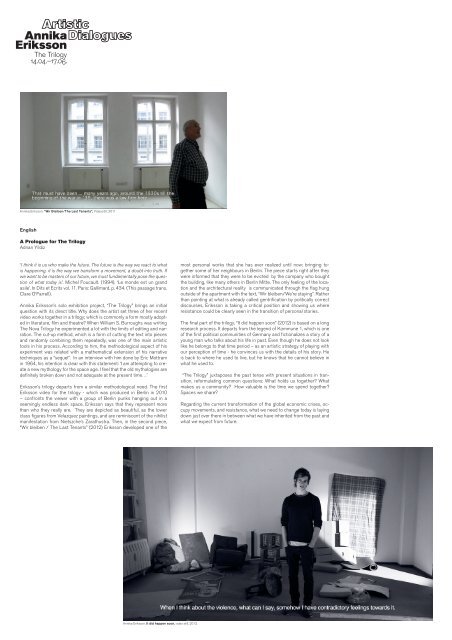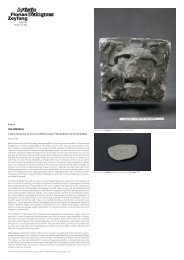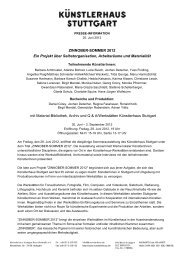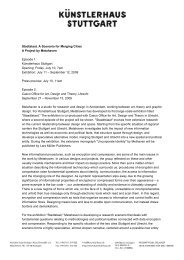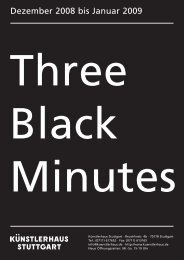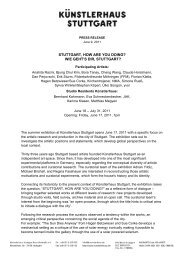Annika Eriksson and Adnan Yildiz in conversation (English/pdf)
Annika Eriksson and Adnan Yildiz in conversation (English/pdf)
Annika Eriksson and Adnan Yildiz in conversation (English/pdf)
Create successful ePaper yourself
Turn your PDF publications into a flip-book with our unique Google optimized e-Paper software.
<strong>Annika</strong><br />
<strong>Eriksson</strong><br />
The Trilogy<br />
14.04.–17.06.<br />
<strong>Annika</strong> <strong>Eriksson</strong>: “Wir Bleiben/The Last Tenants”, Videostill, 2011<br />
<strong>English</strong><br />
A Prologue for The Trilogy<br />
<strong>Adnan</strong> <strong>Yildiz</strong><br />
‘I th<strong>in</strong>k it is us who make the future. The future is the way we react to what<br />
is happen<strong>in</strong>g, it is the way we transform a movement, a doubt <strong>in</strong>to truth. If<br />
we want to be masters of our future, we must fundamentally pose the question<br />
of what today is’. Michel Foucault. (1994). ‘Le monde est un gr<strong>and</strong><br />
asile’. In Dits et Ecrits vol. 11. Paris: Gallimard, p. 434. (This passage trans.<br />
Clare O’Farrell).<br />
<strong>Annika</strong> <strong>Eriksson</strong>’s solo exhibition project, “The Trilogy” br<strong>in</strong>gs an <strong>in</strong>itial<br />
question with its direct title. Why does the artist set three of her recent<br />
video works together <strong>in</strong> a trilogy; which is commonly a form mostly adopted<br />
<strong>in</strong> literature, film <strong>and</strong> theatre? When William S. Burroughs was writ<strong>in</strong>g<br />
The Nova Trilogy he experimented a lot with the limits of edit<strong>in</strong>g <strong>and</strong> narration.<br />
The cut-up method, which is a form of cutt<strong>in</strong>g the text <strong>in</strong>to pieces<br />
<strong>and</strong> r<strong>and</strong>omly comb<strong>in</strong><strong>in</strong>g them repeatedly, was one of the ma<strong>in</strong> artistic<br />
tools <strong>in</strong> his process. Accord<strong>in</strong>g to him, the methodological aspect of his<br />
experiment was related with a mathematical extension of his narrative<br />
techniques as a “sequel”. In an <strong>in</strong>terview with him done by Eric Mottram<br />
<strong>in</strong> 1964, his <strong>in</strong>tention is clear with this statement: ‘I am attempt<strong>in</strong>g to create<br />
a new mythology for the space age. I feel that the old mythologies are<br />
def<strong>in</strong>itely broken down <strong>and</strong> not adequate at the present time…’<br />
<strong>Eriksson</strong>’s trilogy departs from a similar methodological need. The first<br />
<strong>Eriksson</strong> video for the trilogy - which was produced <strong>in</strong> Berl<strong>in</strong> <strong>in</strong> 2010<br />
– confronts the viewer with a group of Berl<strong>in</strong> punks hang<strong>in</strong>g out <strong>in</strong> a<br />
seem<strong>in</strong>gly endless dark space. <strong>Eriksson</strong> says that they represent more<br />
than who they really are. They are depicted as beautiful, as the lower<br />
class figures from Velazquez pa<strong>in</strong>t<strong>in</strong>gs, <strong>and</strong> are rem<strong>in</strong>iscent of the nihilist<br />
manifestation from Nietszche’s Zarathustra. Then, <strong>in</strong> the second piece,<br />
“Wir bleiben / The Last Tenants” (2012) <strong>Eriksson</strong> developed one of the<br />
most personal works that she has ever realized until now; br<strong>in</strong>g<strong>in</strong>g together<br />
some of her neighbours <strong>in</strong> Berl<strong>in</strong>. The piece starts right after they<br />
were <strong>in</strong>formed that they were to be evicted by the company who bought<br />
the build<strong>in</strong>g, like many others <strong>in</strong> Berl<strong>in</strong> Mitte. The only feel<strong>in</strong>g of the location<br />
<strong>and</strong> the architectural reality is communicated through the flag hung<br />
outside of the apartment with the text, “Wir bleiben/We’re stay<strong>in</strong>g”. Rather<br />
than po<strong>in</strong>t<strong>in</strong>g at what is already called gentrification by politically correct<br />
discourses, <strong>Eriksson</strong> is tak<strong>in</strong>g a critical position <strong>and</strong> show<strong>in</strong>g us where<br />
resistance could be clearly seen <strong>in</strong> the transition of personal stories.<br />
The f<strong>in</strong>al part of the trilogy, “It did happen soon” (2012) is based on a long<br />
research process. It departs from the legend of Kommune 1, which is one<br />
of the first political communities of Germany <strong>and</strong> fictionalizes a story of a<br />
young man who talks about his life <strong>in</strong> past. Even though he does not look<br />
like he belongs to that time period – as an artistic strategy of play<strong>in</strong>g with<br />
our perception of time - he conv<strong>in</strong>ces us with the details of his story. He<br />
is back to where he used to live, but he knows that he cannot believe <strong>in</strong><br />
what he used to.<br />
“The Trilogy” juxtaposes the past tense with present situations <strong>in</strong> transition,<br />
reformulat<strong>in</strong>g common questions: What holds us together? What<br />
makes us a community? How valuable is the time we spend together?<br />
Spaces we share?<br />
Regard<strong>in</strong>g the current transformation of the global economic crises, occupy<br />
movements, <strong>and</strong> resistance, what we need to change today is lay<strong>in</strong>g<br />
down just over there <strong>in</strong> between what we have <strong>in</strong>herited from the past <strong>and</strong><br />
what we expect from future.<br />
<strong>Annika</strong> <strong>Eriksson</strong>, It did happen soon, video still, 2012.
An <strong>in</strong>terview with <strong>Annika</strong> <strong>Eriksson</strong><br />
<strong>Adnan</strong> <strong>Yildiz</strong>: “The Trilogy” is based on recent video works<br />
you produced dur<strong>in</strong>g the last three years. How would you<br />
describe your motivation for creat<strong>in</strong>g a trilogy?<br />
<strong>Annika</strong> <strong>Eriksson</strong>: After mak<strong>in</strong>g the first two works, I learned<br />
that they functioned well together <strong>and</strong> I was <strong>in</strong>trigued by the idea<br />
of form<strong>in</strong>g a Trilogy. The idea is appeal<strong>in</strong>g, the first time I encountered<br />
it was with the Star Wars Trilogy <strong>and</strong> from the Swedish play<br />
writer Lars Noren’s trilogy, “Night is the mother of day” these<br />
works had a strong impression on me.<br />
AY: And what br<strong>in</strong>gs them together <strong>in</strong> a set? What are the<br />
connections between the pieces?<br />
AE: In the different parts the preparation process functioned<br />
<strong>in</strong> slightly different ways. With the punks it developed over the<br />
years. I encountered the Berl<strong>in</strong> punks for the first time when I<br />
visited Berl<strong>in</strong> <strong>in</strong> the 80s, they were a significant part of (West)<br />
Berl<strong>in</strong>. I had never seen so many punks anywhere else before<br />
<strong>and</strong> I thought that they functioned like a metaphor for the city.<br />
S<strong>in</strong>ce I moved to Berl<strong>in</strong> they are disappear<strong>in</strong>g every year, <strong>in</strong> the<br />
“New Berl<strong>in</strong>” they are obviously displaced. But they are still as<br />
significant as they disappear. In the film they appear like ghosts<br />
from the 80s or perhaps an idea of a future situation.<br />
With the piece <strong>in</strong> my former home it started already when I<br />
moved <strong>in</strong>, this build<strong>in</strong>g was built <strong>in</strong> 1755 <strong>and</strong> it hosted layers <strong>and</strong><br />
layers of memories, if a build<strong>in</strong>g can ever have a soul this one has<br />
it. I wanted to do a work about it somehow but it took some years<br />
to come to that po<strong>in</strong>t, it was first when it became clear that we<br />
would all have to move out because of new owners. In the film<br />
the people seem like they are forever stuck <strong>in</strong> the build<strong>in</strong>g, their<br />
presence will always rema<strong>in</strong>. This piece turned out to be a work<br />
about resistance <strong>and</strong> time, also a farewell to this build<strong>in</strong>g <strong>and</strong> my<br />
former neighbours, the last tenants.<br />
AE: I have lived <strong>in</strong> Berl<strong>in</strong> for ten years <strong>and</strong> it is a town that is<br />
so full of <strong>in</strong>formation, I am never bored there. In recent years I<br />
have focused on produc<strong>in</strong>g my works where I live, to make works<br />
where I spend most of my time <strong>in</strong>stead of mak<strong>in</strong>g them elsewhere.<br />
It <strong>in</strong>volves less stress <strong>and</strong> more concentration for me <strong>and</strong><br />
it suits me very well.<br />
AY: Dur<strong>in</strong>g 2010, we collaborated for the multi-venue exhibition<br />
project, “correct me if I’m critical” <strong>in</strong> Berl<strong>in</strong> <strong>and</strong><br />
you came up with a performance piece, “<strong>Annika</strong> <strong>Eriksson</strong>´s<br />
Hannah Arendt B<strong>and</strong>”. It featured young boys with an <strong>in</strong>terest<br />
<strong>in</strong> aggressive music; the participation of their peers really<br />
challenged the art audience at Basso, especially those<br />
who expected a fem<strong>in</strong>ist b<strong>and</strong>. I am always <strong>in</strong>terested <strong>in</strong><br />
the way you play with expectations <strong>and</strong> create conceptual<br />
entities from real situations. How do artistic ideas come to<br />
you? How do they f<strong>in</strong>d their forms?<br />
AE: My works emerges from someth<strong>in</strong>g I encounter <strong>and</strong> react<br />
on - often <strong>in</strong> my surround<strong>in</strong>gs - <strong>and</strong> then I take it from there,<br />
sometimes a lot of research is <strong>in</strong>volved sometimes not. I try to<br />
embrace ideas with secrets that will only be clear to me if I execute<br />
the work. But this work belongs to what I call my “displacements<br />
works”. They play with expectations <strong>in</strong> the art world that is<br />
my start<strong>in</strong>g po<strong>in</strong>t. The idea for the “Hannah Arendt B<strong>and</strong>” came<br />
out of a <strong>conversation</strong> we had, you mentioned her as a reference<br />
for the show <strong>and</strong> somehow I reacted on the sound of her name…<br />
Hannah Arendt, Hannah Arendt, N<strong>in</strong>a Hagen, N<strong>in</strong>a Hagen B<strong>and</strong>,<br />
Hannah Arendt B<strong>and</strong>. What would the audience expect from a<br />
female, fem<strong>in</strong>istic, middle aged artist <strong>and</strong> what could it be? It<br />
turned out to be a surprise I th<strong>in</strong>k.<br />
he last work came out of the first parts of the Trilogy. I wanted<br />
to br<strong>in</strong>g the time aspect further, to blur the dist<strong>in</strong>ction of time,<br />
<strong>and</strong> also look upon the idea of resistance <strong>and</strong> political activities<br />
<strong>in</strong> a wider sense. I spent a lot of time look<strong>in</strong>g <strong>in</strong>to the late 60s <strong>in</strong><br />
Berl<strong>in</strong>, especially with the politically oriented communities that<br />
were formed, like Kommune 1 <strong>and</strong> others. I met with one of the<br />
lead<strong>in</strong>g figures, Ra<strong>in</strong>er Langhans <strong>and</strong> others that were more or<br />
less loosely connected to the movement. There is a lot written<br />
<strong>and</strong> documented from this period <strong>and</strong> for awhile I drowned <strong>in</strong><br />
research, but it was necessary to learn <strong>and</strong> try to underst<strong>and</strong><br />
this exceptional post-war situation <strong>in</strong> Germany <strong>and</strong> this generation<br />
of young people com<strong>in</strong>g out of this extremely complicated<br />
situation. This research forms the core of the work but I also took<br />
it further. In the script I <strong>in</strong>serted quotes from people <strong>in</strong>volved <strong>in</strong><br />
this time <strong>and</strong> movement with quotes from science fiction novels,<br />
from Doris Less<strong>in</strong>g for example. Look<strong>in</strong>g at the film we are<br />
perhaps back to the 60s, or perhaps the young man <strong>in</strong> the film<br />
is look<strong>in</strong>g back at someth<strong>in</strong>g that has not yet happened. I would<br />
say that the people appear<strong>in</strong>g <strong>in</strong> the films all come out like some<br />
k<strong>in</strong>d of ghosts trapped <strong>in</strong> time pockets.<br />
A text that was for me especially <strong>in</strong>spir<strong>in</strong>g dur<strong>in</strong>g the last part<br />
was a text by Peio Aquirre, Science Fiction <strong>and</strong> Historicism where<br />
a quote to William Gibson appears: “Halluc<strong>in</strong>ations of Unrealised<br />
Futures”; there is someth<strong>in</strong>g promis<strong>in</strong>g <strong>in</strong> this.<br />
<strong>Annika</strong> <strong>Eriksson</strong>, Wir s<strong>in</strong>d wieder da, 2010.<br />
In all parts the notion of resistance <strong>in</strong> a wider sense is evident.<br />
The punks are totally passive aggressive, refus<strong>in</strong>g to be a part<br />
of a society that they despise; the ones appear<strong>in</strong>g <strong>in</strong> my film<br />
claimed that this passivity was a political act. In the second part<br />
my former neighbours decided to rema<strong>in</strong> <strong>in</strong> the build<strong>in</strong>g <strong>and</strong><br />
claim their rights to do so. They somehow knew that it is nowadays<br />
seen as rather pathetic to hang out a banner claim<strong>in</strong>g that<br />
you are stay<strong>in</strong>g (“Wir bleiben”). As one of them said:<br />
“-but even so who <strong>and</strong> what are we if we don’t even try to resist?”.<br />
In the new part you encounter a person that has an experience<br />
of political activities, but it’s unclear if it is <strong>in</strong> a past or <strong>in</strong> a future.<br />
AY: Why do you th<strong>in</strong>k Berl<strong>in</strong> appears as the production site<br />
<strong>in</strong> all of these video works?<br />
“The Trilogy” is k<strong>in</strong>dly supported by IASPIS <strong>and</strong> the Honorary<br />
Consulate of Sweden, Stuttgart.<br />
For the production of “It did happen soon” (2012),<br />
the artist would like to thank:<br />
Camera <strong>and</strong> edit: Philip Fleischer<br />
Actors: Jan Hallman <strong>and</strong> Nikolas Deutsch<br />
Production manager: Egemen Demirci<br />
Special thanks to:<br />
Frank Berberich, Maria Cruz, Olle <strong>Eriksson</strong>, Fatima Hellberg,<br />
Michael Krome, Sel<strong>in</strong>a Lai, Ra<strong>in</strong>er Langhans, Lettre International,<br />
Elisabeth Pallent<strong>in</strong>, Rotes Antiquariat Berl<strong>in</strong>, Guido Schirmeyer,<br />
Skulpturenpark Berl<strong>in</strong>, <strong>and</strong> Paul Stöcker.<br />
www.künstlerhaus.de<br />
Reuchl<strong>in</strong>str. 4b<br />
70178 Stuttgart<br />
Schedule:<br />
Tuesday, May 15, 2012, 6-9pm<br />
LINIE WEST No. 7<br />
Tour through the gallerie Hauff, Friese, <strong>and</strong> Parrotta as well as Künstlerhaus Stuttgart<br />
www.l<strong>in</strong>iewest.de<br />
6pm: Curatorial Exhibition Tour at Künstlerhaus with <strong>Adnan</strong> <strong>Yildiz</strong><br />
Exhibition hours:<br />
Wed – Fr 3 – 7pm<br />
Sat/Sun 1 – 5pm<br />
Tuesday, June 12, 2012, 7pm<br />
A <strong>conversation</strong> between <strong>Annika</strong> <strong>Eriksson</strong> <strong>and</strong> Maria L<strong>in</strong>d, moderated by <strong>Adnan</strong> <strong>Yildiz</strong>


